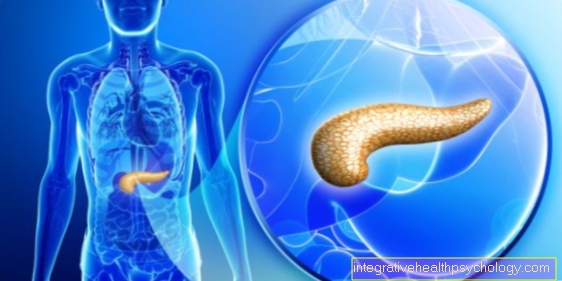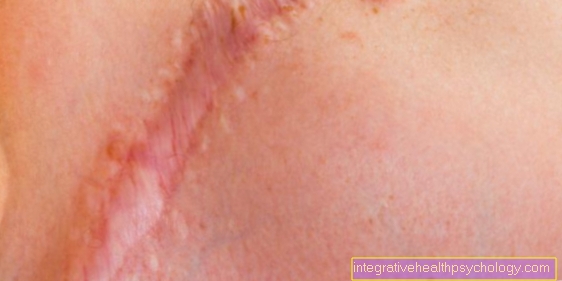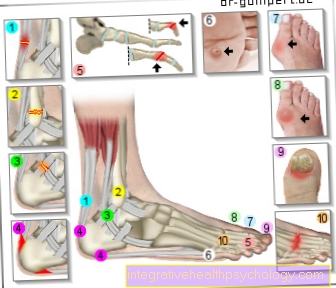Cytomegalovirus
Synonyms
Cytomegalovirus (CMV), Human Cytomegalovirus (HCMV), Human Herpes Virus 5 (HHV 5), Cytomegaly, Cytomegaly
Definition of cytomegalovirus
The Cytomegalovirus is a virus of the family of Herpes viruses, more precisely the? herpesviruses. It contains a double-stranded DNA, which is surrounded by an icosahedral (with 20 surfaces) protein capsule (capsid). Around this, in turn, there is another virus envelope, which is made up of fats and glycoproteins and is very sensitive. The cytomegalovirus reproduces, typical for the genus of? -Herpesviruses, quite slowly and has a narrow host range, so it mainly affects humans.
Cells infected by the virus show up histologically as giant cells with inclusion bodies, also better known as owl eye cells.
The virus can be transmitted both parenterally (blood, Organ transplant) as well as smear and droplet infections (urine, saliva, semen, vaginal and cervical secretions, breast milk). Transmission to the fetus via the placenta during pregnancy is also possible.
Frequency of cytomegalovirus
The Cytomegalovirus is found worldwide. In industrialized countries, it is estimated that up to 70% of the population is infected, while in other geographic regions up to 100% of the population is infected with the virus.
Causes of the cytomegalovirus
The Cytomegalovirus predominantly affects the superficial cells (epithelial cells) of the Salivary glands. Apparently the virus remains in the body for life after an infection (in the salivary glands, kidneys ...).
Symptoms of the cytomegalovirus

In general, the initial infection is with the Cytomegalovirus symptomless or only with very mild symptoms. Only 1-2% of those infected show symptoms. The majority of those affected do not even notice an infection. Precisely for this reason, it has not yet been possible to specify an exact incubation period for the disease. One assumes about 2-10 weeks. A competent immune system is a prerequisite for the infection, which does not appear clinically. If symptoms do occur, they are similar to mononucleosis with fever and swelling of the lymph nodes. Also headache and body aches and rarely Hepatitis (Liver inflammation) and polyneuritides (nerve inflammation) can occur.
In immunosuppressed people such as AIDS patient, Transplant recipients, Leukemia sufferers or tumor patients who are treated with cytostatics, the disease can be severe. Possible complications include severe pneumonia, transplant rejection, retinal involvement in AIDS, which can lead to blindness, and colitis (inflammation of the large intestine) with diarrhea. Additional bacterial infections and ulcers of the gastrointestinal tract are not uncommon and are often very difficult. A fatal outcome is possible.
The infection of the child with the is also serious Cytomegalovirus during pregnancy, which can be life-threatening for the unborn child. The infection with the Cytomegalovirus is the most common infection during pregnancy. It is assumed that around 0.3-4% of all pregnant women become infected and that this infection is transmitted to the child in around 40%. However, only 10% of infected children experience symptoms. If an infection occurs during the first or second trimester of pregnancy, malformations in the child can result. The skeleton, muscles, gastrointestinal tract and cardiovascular system are particularly affected. Also Clotting disorders, Microcephaly (skull too small), Hepatosplenomegaly (enlarged liver and spleen), Jaundice such as Hearing impairment and mental disability are not uncommon. Many of these symptoms do not show up until some time after the birth. The infection is fatal for up to 30% of affected children.
In order to detect an infection during pregnancy, a test for antibodies against it is used today Cytomegalovirus. This is usually done in early pregnancy and repeated around the 20th to 24th week of pregnancy. Illnesses that occur during pregnancy must be reported in any case.
Diagnosis of cytomegalovirus

The diagnosis of the Cytomegalovirus can be detected by antibody detection as well as virus cultivation and polymerase chain reaction. Viral antigens (virus components that can cause immune reactions) can also be detected by means of immunofluorescence, such as the virus' own phosphor protein pp65.
therapy
Since the disease occurs in only a very small percentage of those who are immunocompetent, treatment is generally not necessary. If symptoms do occur, it is usually sufficient to treat only these. It is different with immunosuppressed people: Here are Antivirals how Ganciclovir and Foscarnet used. Acyclovir has been found to be less effective. If there is also a bacterial infection, adequate antibiotic therapy should be sought immediately.
prophylaxis
In immunocompromised patients, vaccination can reduce the body's response to the virus. An infection then shows a less severe effect. This vaccination is used, for example, before a planned one Kidney transplant.





























